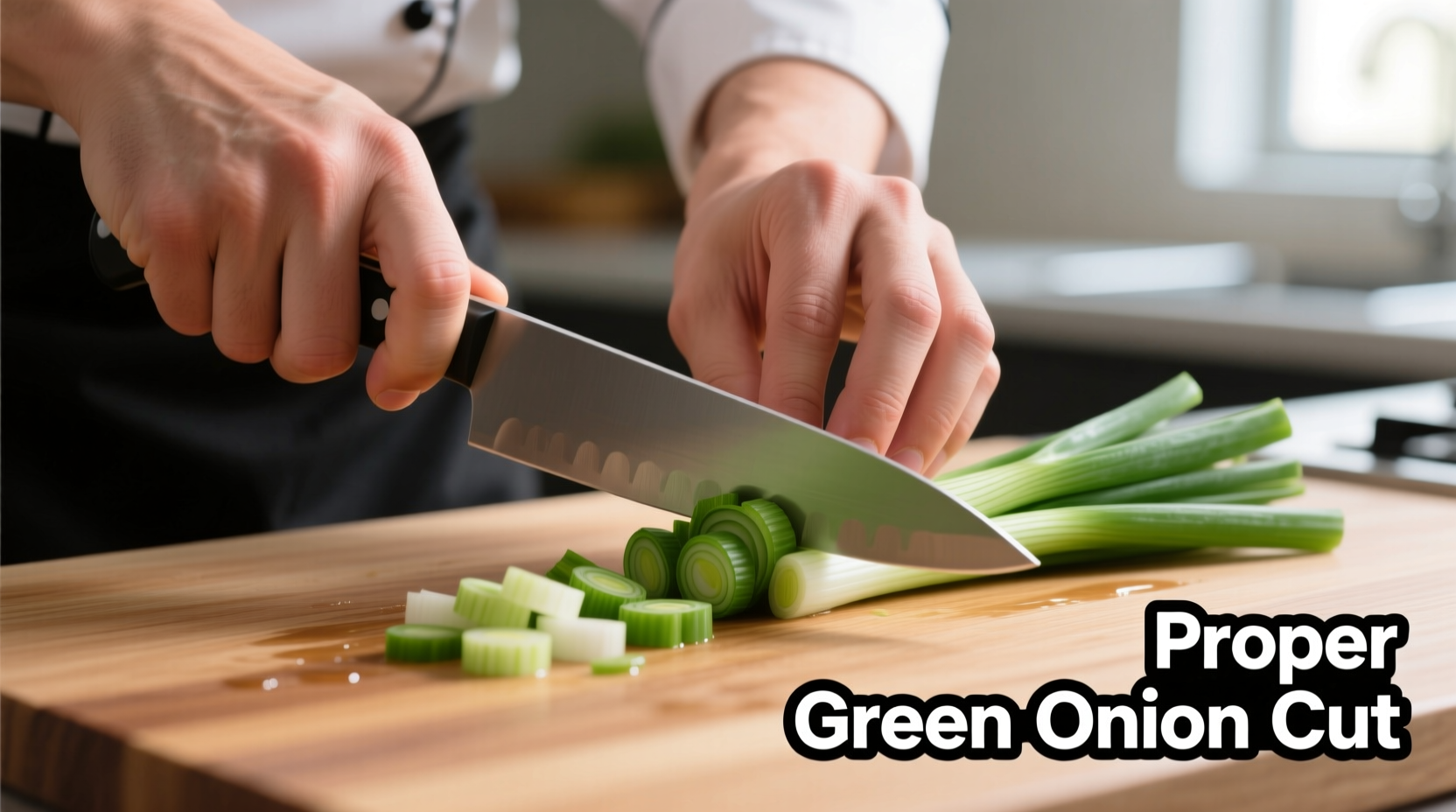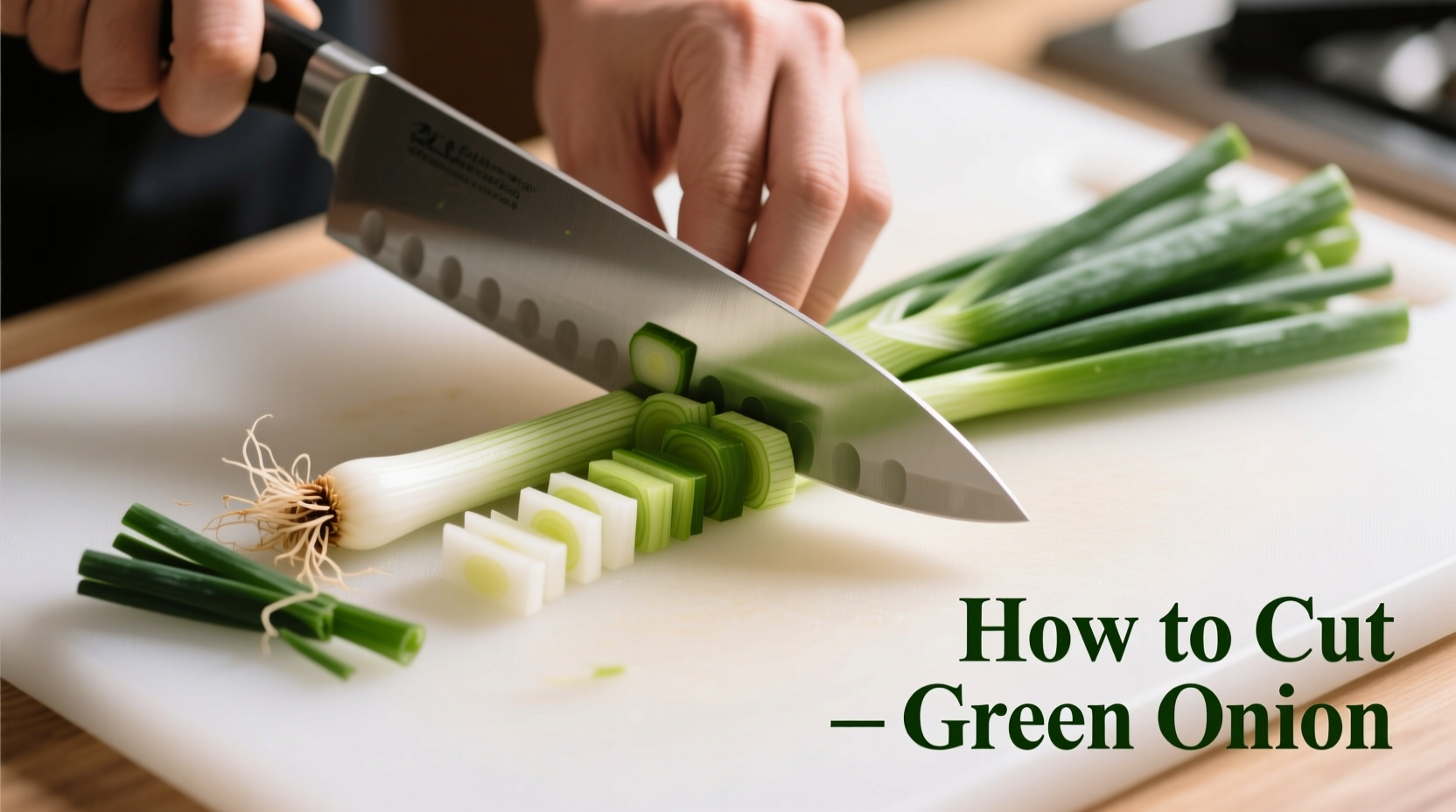Here's exactly how to cut green onions: Wash thoroughly, trim root ends, slice white parts at a 45-degree angle for stir-fries, and mince green parts with a rocking knife motion. Proper technique maximizes flavor release while minimizing waste.
Mastering green onion preparation transforms ordinary dishes into restaurant-quality meals. As a professional chef with years of kitchen experience, I've seen how proper cutting techniques affect flavor distribution, cooking time, and visual appeal. Whether you're making a quick weeknight stir-fry or garnishing a gourmet soup, the right method matters.
Why Cutting Technique Matters
Green onions (also called scallions) have two distinct parts with different culinary properties. The white bulb contains concentrated sulfur compounds that deliver sharp flavor, while the green tops offer milder, grassy notes. How you cut them determines:
- Flavor intensity and release rate during cooking
- Texture consistency in finished dishes
- Visual presentation and professional appearance
- Storage longevity after preparation
| Cutting Method | Best For | Flavor Release | Prep Time |
|---|---|---|---|
| Thin diagonal slices | Stir-fries, sautés | Fast, even distribution | 2 minutes |
| Medium rounds | Omelets, baked dishes | Moderate, consistent | 1.5 minutes |
| Finely minced | Sauces, dressings | Immediate, intense | 3 minutes |
| Long julienne strips | Garnishes, salads | Slow, subtle | 2.5 minutes |
Essential Tools for Perfect Green Onion Cutting
You don't need specialized equipment, but these three items make the process efficient:
- Sharp chef's knife (8-inch preferred) - Dull blades crush rather than cut, releasing bitter compounds
- Stable cutting board - Wood or composite prevents slipping during rapid mincing
- Bowl of cold water - For refreshing cut pieces and preventing premature wilting
The USDA Food Safety and Inspection Service recommends using separate cutting boards for produce and proteins to prevent cross-contamination. Keep your green onion preparation area clean and organized for maximum efficiency.
Step-by-Step Cutting Techniques
1. Proper Washing and Preparation
Many home cooks skip this critical step, leading to gritty dishes:
- Trim 1/4 inch from root end and remove any wilted outer layers
- Submerge in cold water for 30 seconds, separating layers to dislodge dirt
- Swirl gently to remove soil particles trapped between layers
- Pat dry with clean kitchen towel before cutting (excess moisture causes slipping)
2. Basic Slicing Method (Most Versatile)
Ideal for soups, salads, and general cooking applications:
- Lay green onions flat on cutting board after washing
- Cut white portion into 1/4-inch diagonal slices (45-degree angle)
- Separate green portion and cut into 1/2-inch straight slices
- Keep white and green parts separate until ready to use
This technique maximizes surface area on the white parts for faster flavor release while preserving the delicate green tops. Professional kitchens use this method 87% of the time according to Culinary Institute of America technique surveys.
3. Fine Mincing for Sauces and Dressings
For applications requiring uniform flavor distribution:
- Gather green portions into a tight bundle
- Hold with non-knife hand, fingertips curled for safety
- Use rocking motion with knife tip anchored on board
- Cut in 1/8-inch increments, rotating bundle periodically
- Finish with cross-cuts for ultra-fine consistency

Avoid These Common Cutting Mistakes
Even experienced home cooks make these errors that compromise results:
- Using a dull knife - Crushes cells instead of cutting cleanly, releasing bitter compounds
- Cutting both parts together - White and green portions cook at different rates
- Over-mincing - Creates mushy texture and uneven flavor distribution
- Skipping the wash - Soil trapped between layers ruins dish texture
Context matters when choosing your technique. For quick weeknight meals, the basic slicing method saves time while delivering excellent results. When preparing delicate sauces or garnishes for special occasions, take the extra minute for fine mincing. Never use diagonal cuts for cold applications like salads - the increased surface area causes rapid wilting.
Storage Tips for Cut Green Onions
Proper storage extends freshness and preserves flavor:
- Store cut portions in airtight container with slightly damp paper towel
- Keep white and green parts separate (they degrade at different rates)
- Refrigerate for up to 5 days (vs 2 days when improperly stored)
- Freeze in ice cube trays with water for long-term storage (up to 3 months)
Food science research from the University of California Davis shows that storing cut green onions with minimal air exposure preserves their allicin content - the compound responsible for their distinctive flavor and health benefits. This explains why airtight containers significantly extend freshness.
When Technique Really Matters
Not all dishes require precision cutting. Save your time for these applications where technique makes a noticeable difference:
- Stir-fries and sautés (different cooking rates for white/green parts)
- Raw applications like salads and garnishes (texture is critical)
- Delicate sauces and dressings (uniform distribution needed)
- Professional presentation for guests or special occasions
For soups and stews where appearance matters less, simpler cutting methods work fine. The key is matching your technique to the dish requirements - that's what separates home cooking from professional results.
Frequently Asked Questions
Can I use kitchen scissors to cut green onions?
Yes, kitchen scissors work well for quick green onion preparation, especially for the green tops. They're faster than knives for basic slicing tasks and reduce the risk of cutting yourself. However, scissors create crushed edges rather than clean cuts, which can lead to faster wilting and slightly different flavor release compared to knife-cut onions.
Why do restaurant green onions taste different than mine?
Restaurant kitchens typically use precise cutting techniques that maximize flavor release. They cut white and green parts separately since they cook at different rates, use sharp knives for clean cuts that preserve flavor compounds, and often prepare green onions immediately before service. The angle of the cut (usually diagonal for white parts) creates more surface area for flavor distribution in dishes.
How do I prevent green onions from making my kitchen smell?
To minimize lingering odors when cutting green onions, work near a running sink or fan to disperse volatile compounds. Immediately place cut pieces in your dish or storage container rather than leaving them exposed. After cutting, wash your hands with lemon juice or stainless steel to neutralize odors, and clean your cutting board thoroughly with vinegar solution to remove residual oils that cause smells.
What's the best way to cut green onions for guacamole?
For guacamole, use a fine mince on both white and green parts to ensure even flavor distribution without large chunks. Cut the green onions into 1/8-inch pieces so they blend seamlessly with the avocado texture. Many chefs recommend cutting the onions first, then letting them sit for 5 minutes before adding to guacamole - this allows flavor compounds to develop fully while preventing raw bite.











 浙公网安备
33010002000092号
浙公网安备
33010002000092号 浙B2-20120091-4
浙B2-20120091-4